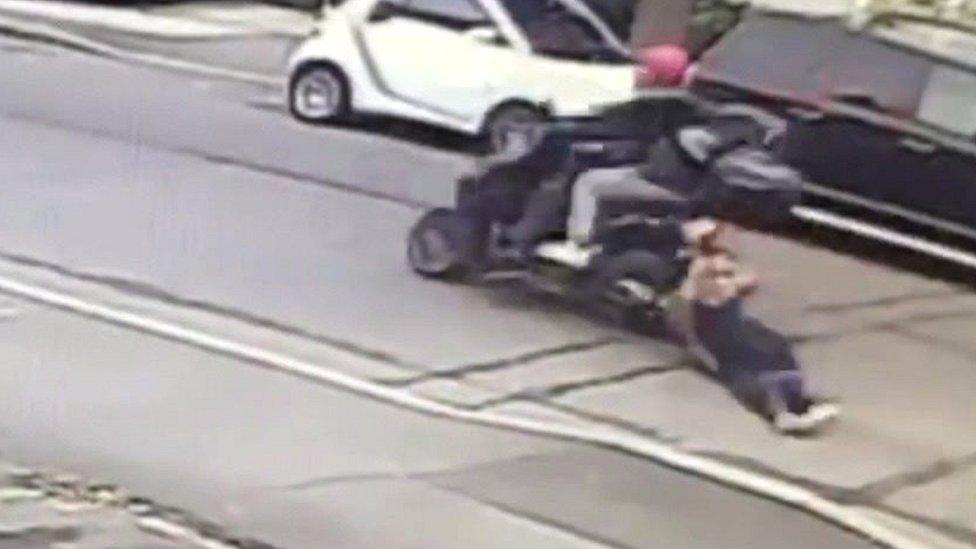The moped and scooter crime wave that has swept London
- Published
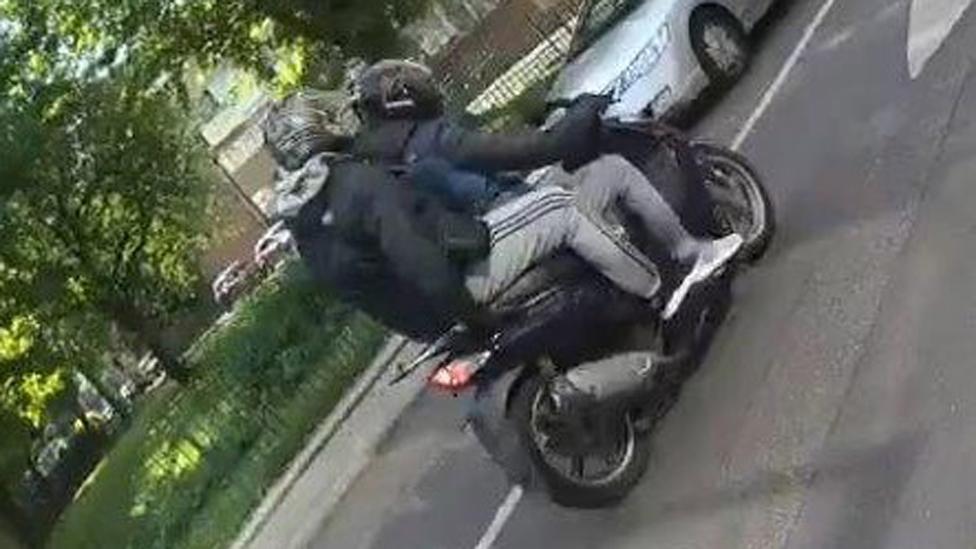
Two people wanted for interview regarding a collision with a pedestrian in Islington, north London
Offences involving scooters and mopeds have rocketed in London, but the epidemic is yet to spread to the rest of the UK.
In one incident on a Friday night, earlier this month, a heavily pregnant woman became a victim of moped criminals.
In a terrifying attack that took only a few seconds, the 31-year-old mother-to-be was knocked to the ground after thieves mounted the pavement from behind her to snatch a mobile phone out of her hand.
I witnessed the aftermath of the attack in north London from an open window of a restaurant a few yards away. I heard the woman's scream and saw her on the floor, but by the time I'd dialled 999 the two robbers had sped off.
The incident, in East Finchley, a relatively low-crime area towards the southern end of the London borough of Barnet, provided further evidence of the spread of the "moped" crime wave.
Pursuit rules 'create moped highwaymen'
(The Metropolitan Police refer to the "step-through-frame" motorcycles commonly used as scooters - mopeds are strictly speaking a subset of scooters, with an engine capacity of less than 50cc).
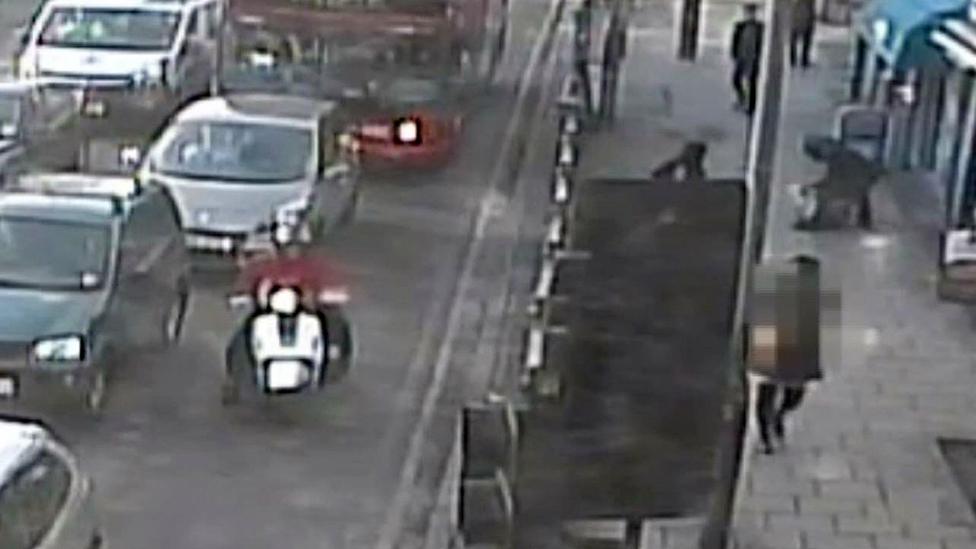
CCTV footage of a moped-enabled robbery in east London, 2016
There are two parts to the crime wave - the theft of the scooters themselves and the offences for which they are used.
The Met says that between July 2016 and June 2017 there were 14,943 thefts of "powered two-wheel vehicles", the vast majority of which were scooters.
The total represents more than 50% of all vehicles stolen in London and is up almost 30% on the previous year.
The calendar year figures show the number of thefts has almost doubled since 2013, though the proportion recovered has increased as well.
It also appears to be a problem largely confined to the capital.
Police in Merseyside and Greater Manchester have set up special teams to combat the illegal use of off-road, or scrambler, bikes, particularly in relation to anti-social behaviour, but none of the major forces we spoke to across Britain flagged scooter theft as a concern on the scale seen in London.
According to the Motorcycle Industry Association, about 60% of all recorded bike thefts in the UK were in London last year, yet just under 10% of all motorcycles and mopeds licensed in the UK were registered to those living in the city.
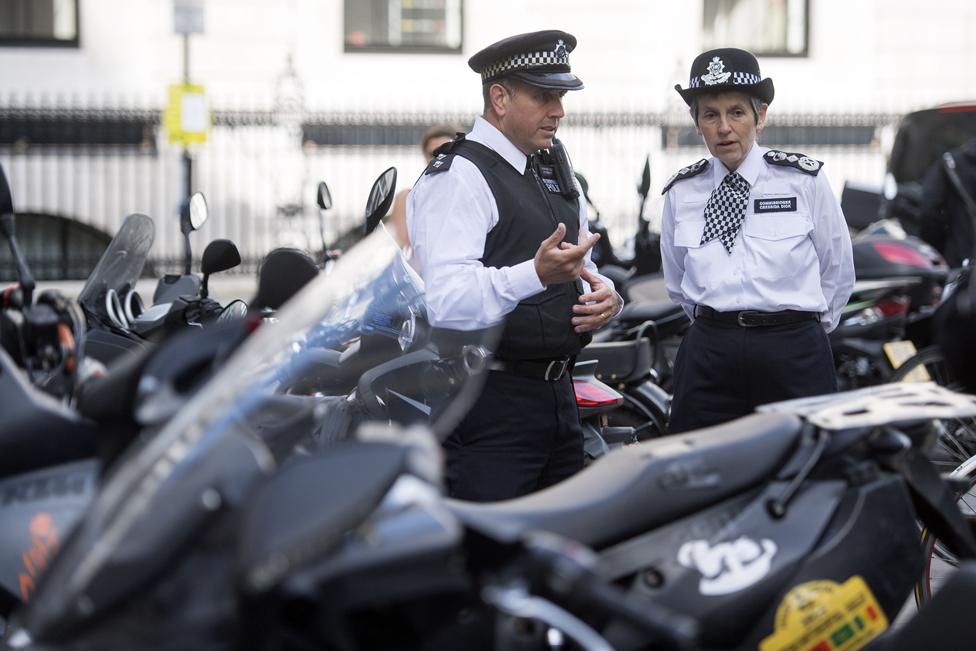
Metropolitan Police Commissioner Cressida Dick (right) meets scooter, motorcycle and moped riders to discuss thefts
The rise in thefts has been sparked in part by an upsurge in the stock of scooters available to be stolen. As the capital becomes more congested and car insurance more costly, scooters have grown in popularity, and as people order more items online, there are more delivery drivers and couriers using them too.
Unlike cars, which have immobilisers, alarms and sophisticated key devices fitted as standard, the main line of defence for a scooter is usually the steering lock, which can be disabled fairly easily. Police recommend other security measures including trackers, marking devices, covers and chain locks - but thieves have been known to cut through those using angle grinders.
Discussions with the motorcycle industry about more effective security are continuing but it's likely to be two or three years before anti-theft systems are embedded into the design of all scooters.
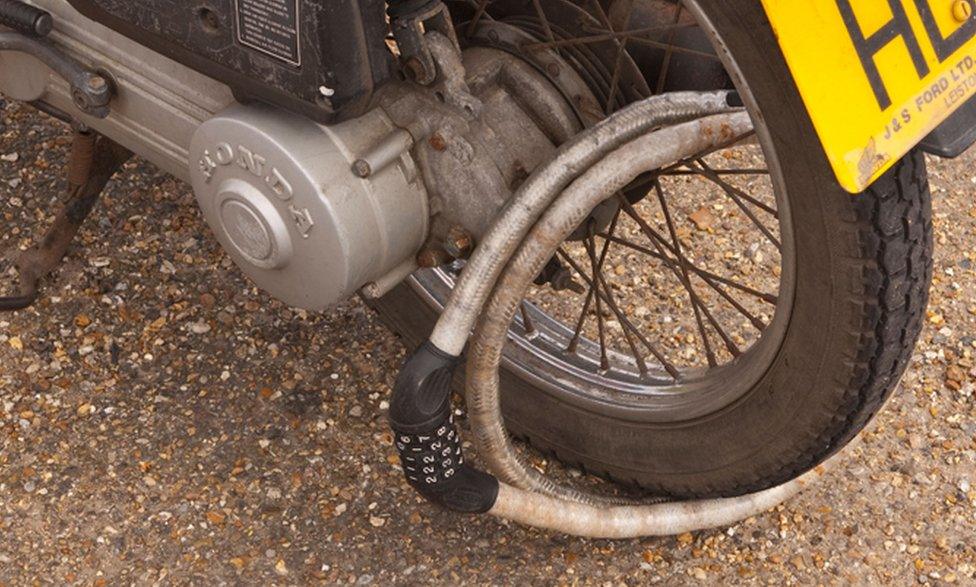
Security for mopeds remains basic for the most part
"Industry can provide the means to secure bikes, but it can't fix the problems that lead to lawlessness," says Steve Kenward, chief executive of the Motorcycle Industry Association.
"That is a matter for police, law-makers and the services which tackle disaffection," he adds.
You might also like:
Calling your husband by name for the first time
Man poisoned after eating cherry seeds
Why does the US military buy so much Viagra?
Simon Harding, senior lecturer in criminology at Middlesex University, says the other "modus operandi" for thieves is "use of force" - getting riders off their scooters by threatening them. No anti-theft device can prevent that.
Dr Harding says although some stolen scooters are stripped for parts or shipped abroad (the average value of each machine stolen is estimated to be £3,000) the main attraction for the gangs is the ability to use them to carry out drug deals and commit other crimes - sometimes as many as 10 in the space of an hour.
The number of such offences recorded by police in London has more than trebled in a year.
In the 12 months to the end of June, the Metropolitan Police logged 16,158 crimes involving powered-two-wheel vehicles compared with 5,145 the year before.
Most of the offences were robbery and theft, with mobile phones making up 90% of items stolen. Phones can be reset within minutes and sold on, or used by gang members who like to have a handful of devices each.
"It's almost the perfect crime because they're committing it with gloves, helmets and visors," says Harding. "It's very difficult to see them, it's all over in seconds...and they're keenly aware that police may not chase them."
Metropolitan Police Deputy Assistant Commissioner Graham McNulty, vehicle crime lead for the National Police Chiefs Council, denies that it is the "perfect crime", pointing out that it is conducted in public, which means there are often witnesses. But he acknowledges that officers will end a pursuit if it gets "too dangerous".
"We do a lot of risk assessment about whether to pursue someone," says Mr McNulty. "Driving in London at speed, with lots of pedestrians, in built-up areas is a high-risk strategy."
An officer embarking on a car chase with criminals on a scooter has to seek authorisation from their control room. A tactical adviser will be on hand and the operation will be overseen by a chief inspector. They will weigh up the risks of the pursuit against the seriousness of the offence of which the rider is suspected.
Police will consider if the suspect might be a danger to the public and if they are on their way to carry out more crimes, as well as conditions on the road - the weather, the time of day and whether there is a lot of other traffic.
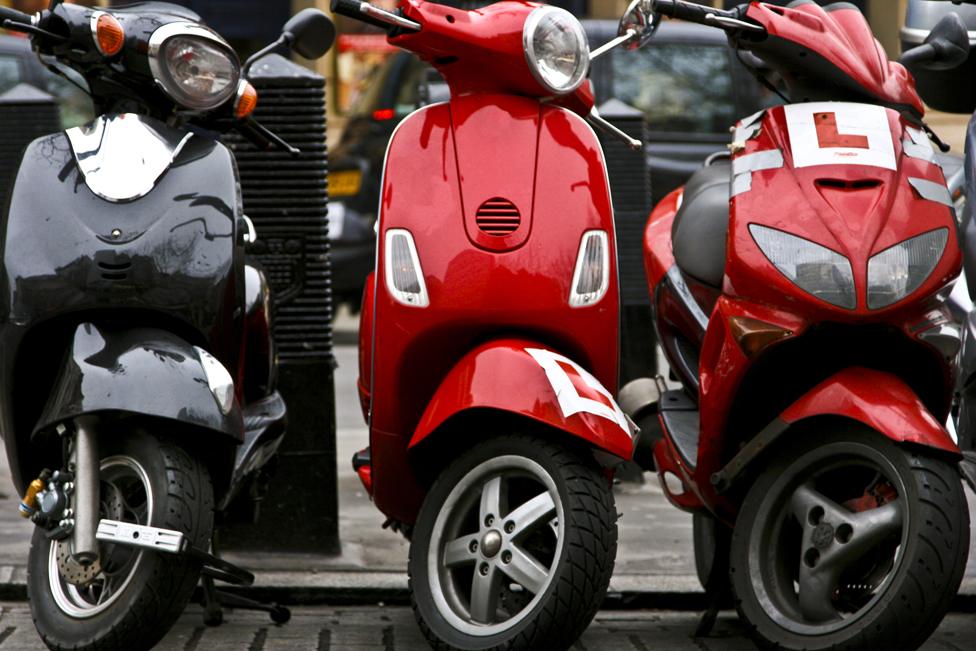
The risks were brought home last year during the inquest into the death of 18-year-old Henry Hicks, who lost control of his moped and crashed after being pursued by two unmarked police cars in north London in December 2014.
The Independent Police Complaints Commission, which investigated the case, said police had "conducted a pursuit without authorisation from a senior officer in the control room" and had failed to "consider the risks to Henry of the pursuit or make any consideration as to whether he may have been a juvenile". Four officers are to face gross misconduct proceedings.
After the case, Scotland Yard issued a reminder to officers about the potential hazards of such pursuits and said it had developed new tactics - including the use of tyre-deflation devices. But there's believed to be a sense among scooter thieves that police have become more cautious about following them at speed.
"People are very well aware of the police tactics, therefore they're picking out vehicles... on the assumption that they're unlikely to be caught," says Daniel Silverstone, director of the Liverpool Centre for Advanced Policing Studies, who's carrying out research on scooter criminals.
"They're deliberately taking their helmets off, so they can't be pursued," he says, claiming police will call off a chase if they know a suspect is more at risk of a head injury.

CCTV footage released by police of moped rider suspected of a robbery in Croydon, south London
Mr McNulty says although suspects removing their helmets is one of the "elements" they have to think about during a pursuit, he says it also gives police a "real advantage" because their face can be seen by victims, bystanders and on CCTV.
Indeed, much of the detective work involves identifying criminals in the hours and days after a pursuit by scouring phone and video footage, tracing the routes they take and looking for fingerprints and DNA evidence.
This week, two men were jailed for robbery, external after the owner of a Vespa was stabbed with a kitchen knife - John Tusting received a 10-year sentence and Lucian Riviere was jailed for eight years.
And last October, a thief who snatched 21 phones in an hour as he drove through five London boroughs was given a three-year sentence.
But in spite of the successes of the Met's anti-scooter crime campaign, Operation Venice, it appears to be an increasingly fashionable way for young criminals in particular to boost their street cred. They post online images of themselves on stolen bikes and circulate stories about what they have done.
"A great deal of it is about how young people are trying to rise above the pack," says Dr Harding. "It's being used to build up street capital, to build up their reputation."
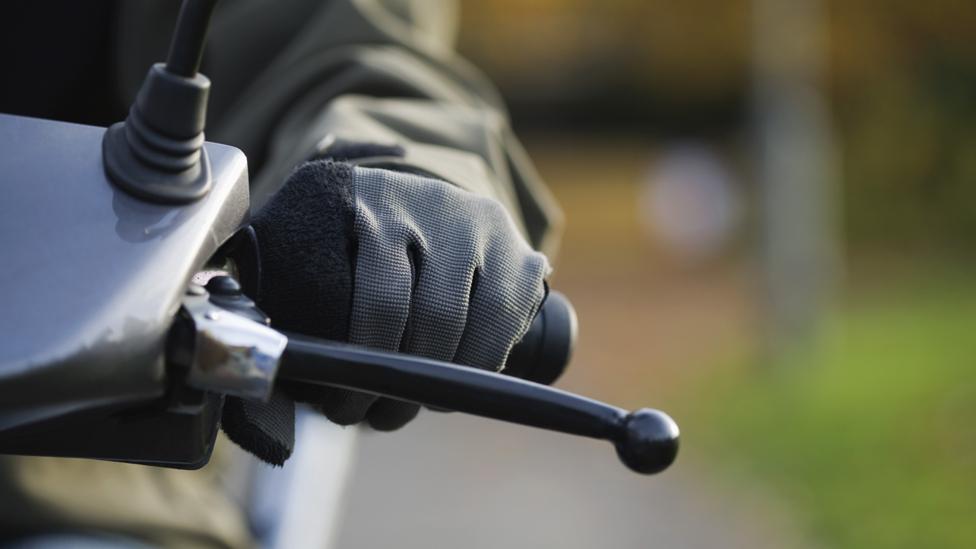
Dr Harding says it is a crime that "suits the moment", with so many potential victims walking around with expensive phones, tablets and headphones, and it offers excitement - from the first stage, stealing the scooter, to the last, escaping from police.
"There is an absolute thrill factor - young people love the theft, the chase, the crime, the buzz - with the chase from police at the end," he says.
The two thieves who stole the pregnant woman's phone in East Finchley were chased by a man on a motorbike who happened to be in the area - but he lost sight of them. Thankfully, the victim's baby was unharmed, although she was left bruised and severely shaken.
There is a fear, however, that the violence is escalating, with a spate of scooter attacks involving corrosive substances in the past few weeks.
There is also concern that it could spread beyond London, which for reasons that are not entirely clear, has so far borne the brunt of this spate of attacks.
For the moment, there is no end in sight to this most mobile of crimes.
- Published19 July 2017
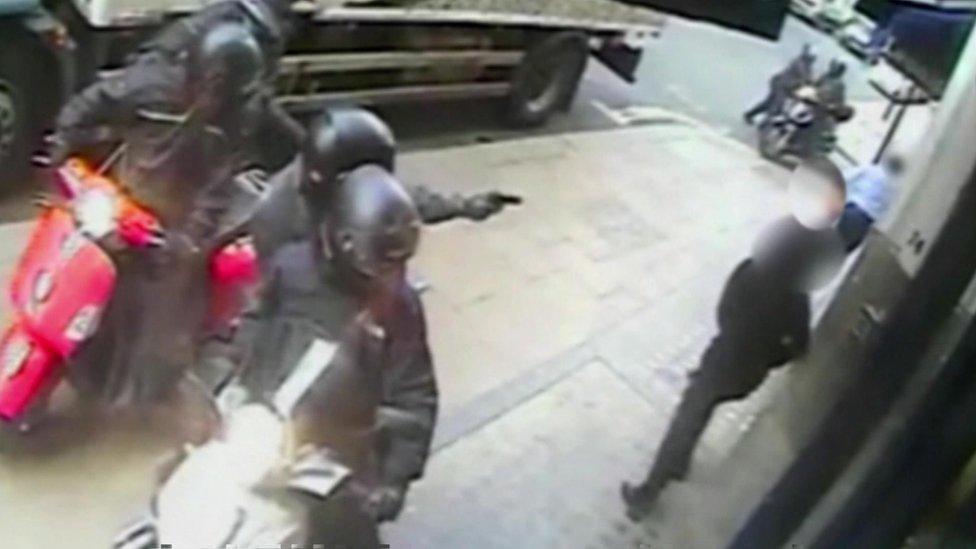
- Published19 July 2017

- Published12 June 2017
